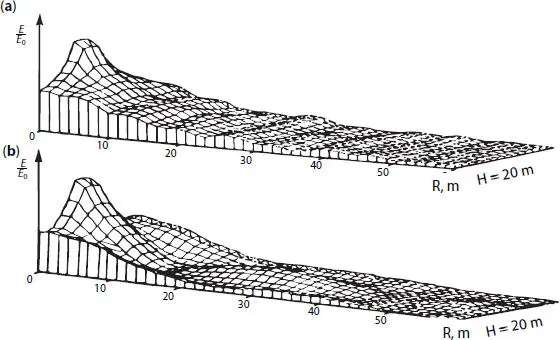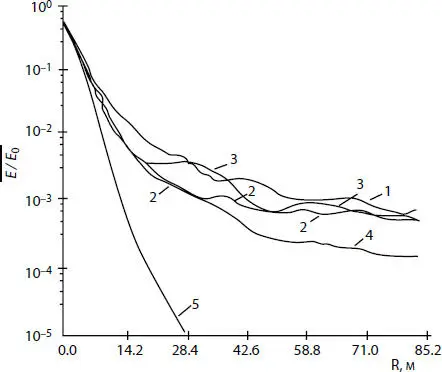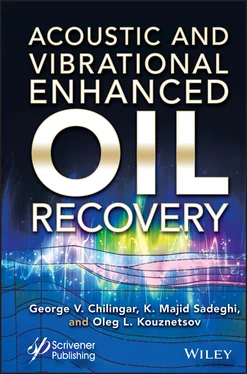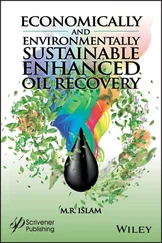
This quantum “is traveling” in the reservoir along a ray trajectory defined by the indicatrix of reflection from the top and base. The quantum’s energy is continuously declining to the local patterns of absorption in the reservoir rocks, wave divergence and angular parameters of reflection coefficients on the porous boundaries. When the quantum is flowing out of the studied portion of the reservoir, a transition is implemented to playing out the subsequent history of the acoustic quantum.
For the evaluation of acoustic properties of the saturated porous medium and description of two-dimensional processes of wave transfiguration on the boundaries, one can use the approach proposed by Sharifullin based on Bio’s linear theory. The offsets of solid and liquid phases (appropriately, uand V) may be determined from Bio’s equations:

Here, λ 1, λ 2, Q, and R are Bio’s elastic moduli for the medium; b = m 2 μ/k is Bio’s resistance coefficient; μ is the fluid’s dynamic viscosity; k the permeability of porous medium; m is porosity; ρ 11, ρ 12, and ρ 22are Bio’s density parameters expressed by rock matrix density ρ 1and fluid density ρ 2as follows:

where ρ 12is the so-called “reduced density”.
The Bio’s moduli may be expressed directly by the measured parameters: rock matrix triaxial compression modulus K , shear modulus G for a “dry” porous medium, and compressibility factors β 1and β 2.
On assuming that in plane OXZ on the separation boundary of two saturated porous media (the boundary coinciding with the OX axis), first or second kind compressional wave or shear wave incidence angle to OZ axis is α. The OZ axis is directed into the second medium. In the general case, six types of waves are generated on the boundary, three are reflected and three are refracted.
This approach was implemented for computing phase velocities, free space attenuation factors, angular wave transformation factors, and energy reflection parameters at reservoir’s boundaries. These parameters are needed for a “raffle” of the acoustic “quanta” trajectories.
The same way was modeled a great number of the acoustic quanta trajectories flowing from the source in all possible directions. A field intensity was computed in 2.5 to 5 thousand of the reservoir points using the energy flux vector:

where A is amplitude of wave potential in the medium and C mis the phase velocity of m -wave.
The exit angle of each “quantum” trajectory ray of 0° to 180° was “raffled” using pseudorandom number sensor for the numbers uniformly distributed in the zero to one interval. The field near every of 5,000 observation points was averaged on the surface of a cell with the side H /50, where H is the reservoir thickness. Thus, phase displacement at the quanta superposition in a given point was taken into account by that separate cells have been provided for accumulating two orthogonal components of the wave vector at every point of the reservoir. Modeling was being performed in the mode of continuous information accumulation with releasing results over a certain number of histories— “acoustic quanta exits” from the source. The result at each release was normalized per a number of hits in every reservoir cell. For calculating the hit numbers, a special two-dimensional massif was included in the memory.
Computations have been conducted of the spatial-energy distribution of the well vibration source field in the oil-saturated productive reservoirs restricted by a low permeability water-saturated top and base. At constructing of the reservoir and enclosing rocks’ design model have been used real field-geologic property data of the reservoirs, oils, reservoir water and enclosing rocks. The reservoir thickness varied in the range of 5 to 30 m. As source parameters have been taken average parameters for each type of boundary of porosity, permeability, solid phase and saturating fluid density, rock triaxial compression, and shear moduli. The top and base rocks have been assumed practically impermeable and saturated with reservoir water having density of 1.188·10 3kg/m 3and viscosity of 0.05 cP or gas with density of 70 kg/m 3and viscosity of 0.015 cP. In Figure 2.1, relative fields of vibration intensity for various frequencies in an oil-saturated reservoir, 20-m thick, are shown. The obtained spatial distributions of vibrational energy flow density from the vibration source in the reservoir are wave pictures with interference maxima and minima illustrating a substantial influence by the top and base depending on frequency.

Figure 2.1 Relative intensity of vibration fields E/E 0vs. reservoir thickness H, distance from vibration source R and frequency: (a) 12-Hz frequency and (b) 120-Hz frequency.
Figure 2.2is relative change in the intensity of elastic vibrations vs. the distance to the vibration source for various frequencies. The curves are derived by averaging of field massifs over the reservoir thickness. At frequency over 1 kHz, monotonous and substantial decline in vibration intensity with an increase in distance to the source is observed. At frequency over 10 kHz, the influence of boundaries on the field in the reservoir is negligible (curve 5 ). At low frequency, there are certain frequencies at which a sharp energy decline starting at some distance from the source is replaced by a smooth alternation of maxima and minima.
This phenomenon indicates that at those frequencies in the reservoir vibrational mode are generated expanding without a noticeable energy radiation from the reservoir into enclosing nonproductive rocks. In these rocks, the vibration intensity decline with distance is caused only by cylindrical divergence and spatial absorption, which is not too great at low frequency. The most clearly expressed normal mode for a 20-m-thick reservoir is recorded near the frequency of 120 Hz. An increase in energy flow density in the reservoir at substantial distance from the vibration source in this frequency area in comparison with the field intensity even for very low frequencies is perhaps indicating a possibility of existence in the oil reservoirs of the resonance activation regimes; these are characterized by a substantial decline in the energy fraction dispersed in the nonproductive rocks enclosing the reservoir and an increase of the energy fraction penetrating within the reservoir.

Читать дальше


















